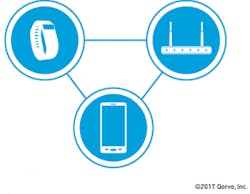Wi-Fi 6 Is Coming! Get Ready!
What’s in Store for Service Providers and End Users?
Wi-Fi 6 is expected to be ratified by late 2019, and ABI Research (https://www.abiresearch.com) forecasts Wi-Fi 6 chipsets will break a 1 billion annual shipments barrier by 2022. Its real-life throughput experience may be 4 times as much than its predecessor Wi-Fi 5 (.11ac). This has significant consequences for consumers and service providers.
For the consumer, there are always 2 things that matter. The first is performance (data rate). The second is range (e.g., How can I get the highest speed in every corner in my house, backyard, basement, etc.?).
In urban areas, consumers have grown accustomed to what is now a common scenario: turning on a laptop and weeding through many routers or access points that are visible when trying to find a Wi-Fi network. Many of the routers use the limited number of overlapping channels, which means users are sharing those channels. Or to put it another way: there is interference on those channels.
When 2 devices are talking through each other, over the same channel at the same moment, it means that the messages are getting garbled, and both need to be sent again. It’s no surprise, then, that the throughput in dense environments can collapse in continuous retransmissions.
This interference is made worse by the fact that routers and access points have attempted to improve range via the highest output power possible. Anyone who has ever been to a crowded party can understand this scenario. The more everyone speaks louder to be heard, the more the overall noise goes up and any real opportunity to communicate goes down.
More output power just causes more interference. Even worse, higher output power in some channels of the band causes signal to "bleed" into the neighboring channels — another form of interference — causing the capacity of the band and the total Wi-Fi system to degrade.
So, what to do?
This is where Wi-Fi 6 (.11ax) comes into play. The goal of this new standard is less about higher data rates, and more about the use of as many channels in the 2.4 GHz band or the 5 GHz band (and soon to follow, the 6 GHz band) as possible — at the same moment in the same space (for instance, in the same house).
Let’s look at an example of why this is needed. Imagine a family living in a house with multiple rooms, running different applications at the same time. In the past, this meant that everyone was using the same channel to communicate with the central router in the closet, but with all the interference limitations discussed earlier.
The scenario that Wi-Fi 6 enables is that every room in the house has a small access point (the size of a cigarette pack) running on a different Wi-Fi channel. Those access points are wirelessly connected over Wi-Fi to the central router in the closet. This allows the applications to run on different channels and not interfere with each other. This is a true Wi-Fi system. The name of the game now is total capacity: using multiple channels simultaneously without interfering with each other, thereby optimizing total indoor throughput.
"Talk Through" Challenges
If the goal of Wi-Fi 6 is full coverage of a home (or a building), and maximum performance in every room, what happens if 2 devices are "talking through each other"? Smartphones, computers, tablets and routers communicating with each other on the same channel sometimes "talk through each other." Not surprisingly, this jumbles the communication.
InvisiLight® Solution for Deploying Fiber
April 2, 2022Go to Market Faster. Speed up Network Deployment
April 2, 2022Episode 10: Fiber Optic Closure Specs Explained…
April 1, 2022Food for Thought from Our 2022 ICT Visionaries
April 1, 2022A sending device usually knows that a packet has not arrived, because it does not receive an acknowledgement back from the receiving device within a certain time frame. (We’re talking milliseconds here.) The mechanism with which devices communicate is called a protocol, which describes how proper communication needs to be handled, including what to do when "talking through each other."
A simple part of a protocol is "listen before talking," which means that before a device starts to send a data packet, it listens to ensure that nobody else is "on the air." But, if 2 devices both listen, and both conclude that the "air is clear" and start communicating at the same time, it creates a collision. Some devices can "hear" the interference and will "back off," or stop and wait (again, milliseconds) before sending again.
So, typically what happens in dense environments is that more packets collide, and more packets need to be retransmitted with now higher chances of another collision.
The consequence is that the performance of the network as a whole can break down. This is what happens, for example, with too many people on a single hotspot.
What does this mean for ICT service providers?
So, the immediate impact in hotspot service providers is that they can equip their hotspots easily with multi-channel hotspots, where many more users can be more easily distributed over different channels in the hotspot area — a clear example of how Wi-Fi 6 is going to be a big step forward.
There is one final question of note in this scenario. Assuming an access point in every room, and all the access points talking with the router in the closet over Wi-Fi, what frequency bands are preferred? Since 2.4 GHz gives better range than 5 GHz, a logical choice would use 2.4 GHz as the backbone and 5 GHz as the connection between the access point and the end device.
There is a little issue, though. The backbone is supposed to aggregate the traffic, which means that it is supposed to have the higher data rate (performance). In reality, the data rate at 5 GHz is higher than at 2.4 GHz, in particular because more channels can be bundled together in the 5 GHz band. However, the range at 5 GHz is less, and therefore it is less suitable for a backbone function.
So, not surprisingly, you can find products today that have different Wi-Fi system design philosophies. Some have 2.4 GHz as a backbone, while others are using 5 GHz for that. The industry clearly is not unanimous about this yet.
Like this Article?
Subscribe to ISE magazine and start receiving your FREE monthly copy today!
And since indoor radio behavior can be fickle, there may not be an ultimate final solution — other than these distributed Wi-Fi systems configuring themselves based on optimizing the indoor environment, if the systems get smart enough. This configuration can even be made dynamic, based on the data consumption requirements in various parts of the distributed Wi-Fi system. This means it would reconfigure itself automatically as it understands the complete environment, including negotiating with the neighbors so everyone gets a fair share of the spectrum!
For the Wi-Fi 6 end user, management of the different channels or signing up to 2.4 GHz or 5 GHz networks
all disappears. Wi-Fi 6 will show itself to the user as 1 network, with 1 password. Extended networks or different passwords will be a thing of the past, which makes getting or staying connected very easy.
For the service provider this means that when Wi-Fi users are starting to use applications with higher bandwidth demand, the access network should not be forgotten. Most of the Internet users these days still have less than 100 Mb/s bandwidth to their home. Further increasing the data rate and the capacity in the home will make sense only when higher data rates to the home will become available — a challenge that clearly needs to be addressed.
Let the network evolution continue.
About the Author






